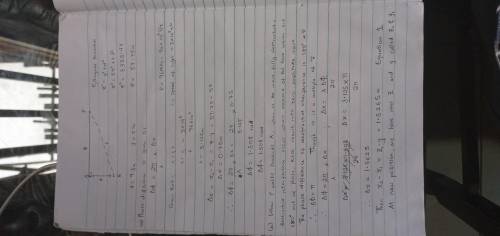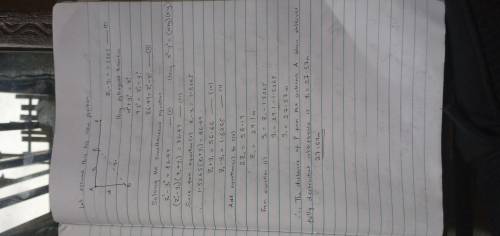
Physics, 22.02.2020 02:07 noahdeem135
Two antennas located at points A and B are broadcasting radio waves of frequency 96.0 MHz, perfectly in phase with each other. The two antennas are separated by a distance d=9.30m. An observer, P, is located on the x axis, a distance x=57.0m from antenna A, so that APB forms a right triangle with PB as hypotenuse. What is the phase difference between the waves arriving at P from antennas A and B?
Now observer P walks along the x axis toward antenna A. What is P's distance from A when he first observes fully destructive interference between the two waves?

Answers: 3


Other questions on the subject: Physics

Physics, 22.06.2019 13:20, Jbutler15
This energy transformation diagram represents the energy of a skateboarder moving along a half-pipe. as she skates toward the top of the half-pipe, her original kinetic energy is converted to potential energy and friction. how much of the energy is potential?
Answers: 3

Physics, 22.06.2019 17:00, jenn8055
In the future, people will only enjoy one sport: electrodisc. in this sport, you gain points when you cause metallic discs hovering on a field to exchange charge. you are an electrodisc player playing the popular four disc variant. the disks have charges of qa = −8.0 µc, qb = −2.0 µc, qc = +5.0 µc, and qd = +12.0 µc. (1) you bring two disks together and then separate them. you measure the resulting charge of these two disks and find that it is +5.0 µc per disk. which two disks did you bring together? (a) a and b (b) a and c (c)a and d (d)b and c(e) b and d (f) c and d. (2) you bring three disks together and then separate them. you measure the resulting charge of these three disks and find that it is +3.0 µc per disk. which three disks did you bring together? a, b, and c (a) a, b, and d (c) a, c, and d (d) b, c, and d. (3) given the resulting charge of each disk measured in (b) is +3.0 µc, how many electrons would you need to add to a disk of this charge to electrically neutralize it? electrons
Answers: 3

Physics, 23.06.2019 08:00, edjiejwi
Athin electrical heater is inserted between a long circular rod and a concentric tube with inner and outer radii of 20 and 40 mm. the rod (a) has a thermal conductivity of ka = 0.15 w/(m*k), while the tube (b) has a thermal conductivity of kb = 0.8 w/(m*k) and its outer surface is subjected to convection with a fluid of temperature t= -15°c and heat transfer coefficient 60 w/(m2 *k). the thermal contact resistance between the cylinder surfaces and the heater is negligible. (a) determine the electrical power per unit length of the cylinders (w/m) that is required to maintain the outer surface of cylinder b at 15°c. (b) what is the temperature at the center of cylinder a?
Answers: 2

Physics, 23.06.2019 12:30, Ladarius622
You have decided to host a discussion about post-traumatic stress disorder with the families of soldier abroad provide an over view of the disorder the symptoms and consequences of ptsd
Answers: 2
You know the right answer?
Two antennas located at points A and B are broadcasting radio waves of frequency 96.0 MHz, perfectly...
Questions in other subjects:

Mathematics, 18.03.2021 03:30


Mathematics, 18.03.2021 03:30

Mathematics, 18.03.2021 03:30


Mathematics, 18.03.2021 03:30

Mathematics, 18.03.2021 03:30



Mathematics, 18.03.2021 03:30





